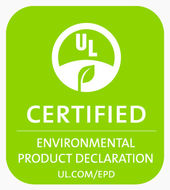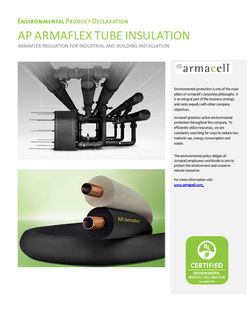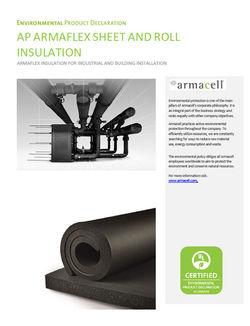 Flexible insulation materials are among the few industrially made products which save more energy over the product lifecycle than is needed for their manufacture. However, Armacell is always seeking new ways to decrease energy usage and reduce environmental impact.
Flexible insulation materials are among the few industrially made products which save more energy over the product lifecycle than is needed for their manufacture. However, Armacell is always seeking new ways to decrease energy usage and reduce environmental impact.
To demonstrate our commitment, Armacell just published two new Environmental Product Declarations for our AP ArmaFlex pipe and sheet and roll insulation in North America. The third-party documents are the first EPDs released by any elastomeric foam insulation manufacturer in the U.S.
What is an EPD?
 According to UL, an EPD is a “comprehensive, internationally harmonized report created by a product manufacturer that documents the ways in which a product, throughout its lifecycle, affects the environment.” Armacell engaged sustainability consulting firm, Ecovane, to prepare the reports, and entrusted UL to certify that all information in our finished EPD is accurate.
According to UL, an EPD is a “comprehensive, internationally harmonized report created by a product manufacturer that documents the ways in which a product, throughout its lifecycle, affects the environment.” Armacell engaged sustainability consulting firm, Ecovane, to prepare the reports, and entrusted UL to certify that all information in our finished EPD is accurate.
EPDs can be developed after a product life cycle assessment (LCA) is conducted and are based on applicable product category rules (PCRs). Each EPD report discloses the lifecycle of the product in a single, comprehensive document. The EPDs provide reliable “cradle to installation with end-of-life” information about the product’s resource usage and waste output as well as its impact on the environment, such as global warming potential, ozone depletion and ecotoxicity.
Why is an EPD important?
Following our corporate philosophy and to promote the principles of the UN Global Compact, Armacell is always undertaking initiatives to promote greater environmental responsibility. One way to do that is to provide greater material transparency to support environmental and sustainable design.
Green building schemes such as the U.S. Green Building Council’s LEED®, the International WELL Building Institute’s WELL Building Standard® and the Living Building ChallengeSM, among others, expect material transparency to achieve green building credits. As a leader in the flexible elastomeric foam industry, Armacell is committed to material and resources transparency and fully supports providing green building designers the information they need to make sustainable design choices.
Benefits for Green Building Credits
An EPD with product category rules may contribute to the following green building credits:* **
| BREEAM Mat 02 | BREEAM New Construction 2018: Environmental impacts from construction products – Environmental Product Declarations (EPD) |
| CHPS, MW 7.1 | Collaborative for High Performance Schools: Environmental Product Declarations |
| Green Globes | The Green Globes System |
| LEED v4 EPD option 1 & 2 | LEED BD+C: NC v4 | Building product disclosure and optimization - environmental product declarations |
| LEED v4.1 EPD option 1 & 2 | LEED BD+C: NC v4.1 | Building product disclosure and optimization - environmental product declarations |
*You should consult a green building accredited professional for details about the credits above.
Commitment to Transparency
 Environmental protection is one of the main pillars of Armacell’s corporate philosophy. It is an integral part of the business strategy and ranks equally with other company objectives. Armacell practices active environmental protection throughout the company. To efficiently utilize resources, we are constantly searching for ways to reduce raw material use, energy consumption and waste. Our environmental policy obliges all Armacell employees worldwide to aim to protect the environment and conserve natural resources.
Environmental protection is one of the main pillars of Armacell’s corporate philosophy. It is an integral part of the business strategy and ranks equally with other company objectives. Armacell practices active environmental protection throughout the company. To efficiently utilize resources, we are constantly searching for ways to reduce raw material use, energy consumption and waste. Our environmental policy obliges all Armacell employees worldwide to aim to protect the environment and conserve natural resources.
Armacell’s EPDs are available for download on UL’s SPOT green products database at https://spot.ul.com/. Housing more than 130,000 products, SPOT is the largest credible sustainable product database with solutions for architects, manufacturers, retailers and professional purchasers.
**Footnote: https://www.transparencycatalog.com/rating-systems
